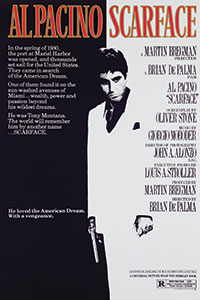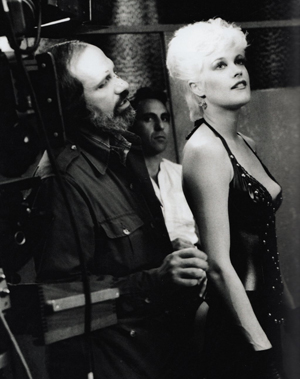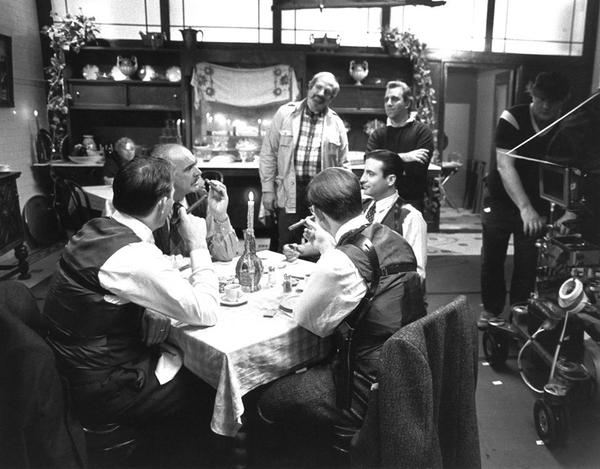"DOES THE VOYEUR NEED THE EXHIBITIONIST OR DOES HE WANT TO BE HER?"

Chris Randle, a New York writer who has contributed to Hazlitt, The Guardian, Pitchfork, and the New York Times Magazine, among other publications, has written a long essay about Brian De Palma's cinema, which was posted earlier this week at REAL LIFE. The essay is titled "Night Visions," posted with the subheadline, "Does the voyeur need the exhibitionist or does he want to be her? Brian De Palma’s movies see it both ways." It is an engrossing essay, definitely worth reading in its entirety. Here's an excerpt:
De Palma’s earliest films were less precise, and sometimes more revealing: They don’t disguise his fixations as genre. The mercurial black comedy Hi Mom! trails like a disorderly kid after Jean-Luc Godard, through whom De Palma arrived at Brechtian ideas of estrangement — telling a story while displaying the artifice involved, so that viewers might act upon the fiction rather than just receiving it. A woman testing out a movie camera zooms in on the salesman, bearing the device to bare the device: “You twist this like so, and your subject will come closer and closer and closer…” An antic young Robert De Niro stars as Jon Rubin, who films neighbours fucking and tries to contrive porn spying on himself — then as now, the wrong angles will ruin your nude. Later he rehearses the cop’s role for a militant theater troupe, clanging his baton against a ladder with unnerving enthusiasm: “What are you protesting? Let me see your permit. You don’t need a permit?” (During the early 1960s De Palma was shot in the leg by New York police, albeit while drunkenly stealing a scooter.)In “The Work of Art in the Age of Mechanical Reproduction,” Walter Benjamin marveled: “The painting invites the spectator to contemplation; before it the spectator can abandon himself to his associations. Before the movie frame he cannot do so. No sooner has his eye grasped a scene than it is already changed. It cannot be arrested.” De Palma tosses his narratives like a bloody knife into the laps of bystanders, who then feel compelled to solve the crime, to absolve their complicity. He’s always resisting arrest. A long Steadicam shot from Raising Cain (1992) glides with unnatural grace past the walkways, staircases and elevators of a police station, tilting sinuously around a criminal psychologist as she explains the plot; exposition is a maze De Palma dances through. His Battleship Potemkin tribute in The Untouchables — staircase, baby carriage, crossfire — seems alien to the movie around it, a bubble trembling over a gun barrel.
The split screen, De Palma’s favorite technique, concentrates distraction. It suggests the flux of sexual difference, darting between signals, your lens rupturing, your life juxtaposed against itself. Some of these compositions turn slyly dialectical: Passion (2012) places scenes from a Jerome Robbins ballet next to a sinister prowler, the bodies hovering in parallel. But that sequence also misdirects the viewer’s attention at crucial moments, a trick De Palma has used since 1973’s Sisters, his first thriller.
Sisters opens with a blind woman entering the wrong change room. A watching man stops her as she begins undressing, and the camera cuts away to reveal that people are watching them too, on the test-your-ethics game show Peeping Toms. The woman turns out to be a Quebecois model/actress named Danielle (Margot Kidder), and she convinces that fellow contestant to take her home with him, away from the ex-husband who’s been following her. After they wake up on the couch together, he learns of her twin Danielle, too late to realize that the other sister’s protective urges are homicidal. A neighbor sees his hand flash scarlet from window to window. Split-screen shots break the aftermath into fragments, that cubist shape of time experienced through security cameras, making everyone’s movements look both frantic and dazed.
The neighbor, Grace (Jennifer Salt), happens to be a journalist, and she tracks down an old documentary about Danielle and Dominique, revealing that the pair were once conjoined. Dominique died during the botched operation meant to give Danielle’s ex Emil Breton a compliantly solitary wife, her personality somehow absorbed by the remaining twin. Investigating a mental hospital, Grace gets drugged by Dr. Breton, who nearly manages to portray her suspicions as symptoms. She hallucinates herself inside that documentary, lying beneath a surgical blade passed around on reverent palms. Thirty years ago the critic Robin Wood argued: “One can define the monster of Sisters as women’s liberation; adding only that the film follows the time-honored horror tradition of making the monster emerge as the most sympathetic character.” The medical system encourages Emil’s urge to discipline anyone complicating gender or anatomy.
Evil twins have more fun. In his study The Double, the psychoanalyst Otto Rank argued that doppelgangers often serve as a “bad self,” the splinter persona responsible for each forbidden urge. The sadistic executive played by Rachel McAdams in Passion invites lovers to wear a mask stylized after her own face. No character spends much time having sex per se. The perverse intimacies of jealousy get them off: They all want each other, or to kill each other, or to be each other. No wonder so many people fantasize about their double — about knowing what it looks like from the outside.










 Joe Napolitano passed away July 23 in Los Angeles, following a battle with cancer,
Joe Napolitano passed away July 23 in Los Angeles, following a battle with cancer, 


 Danny McBride, co-creator of HBO's Vice Principals, talked to
Danny McBride, co-creator of HBO's Vice Principals, talked to